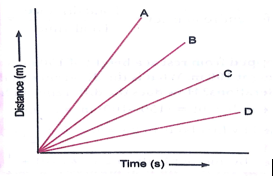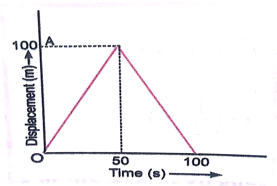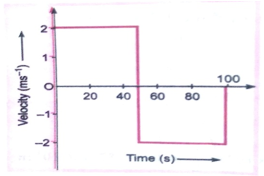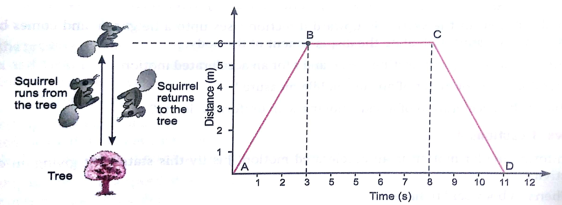Motion
Que 1. Four cars A, B, C and D are moving on a levelled road. Their distance versus time are shown in figure. Which car is the slowest?
Ans. Speed = Slope of distance-time graph. The smaller the slope, the smaller is the speed. From the figure, slope is minimum for car D. So, D is the slowest car.

Que 2. A girl walks along a straight path to drop a letter in the letterbox and comes back to her initial position. Her displacement-time graph is shown in figure. Plot a velocity-time graph for the same.

Ans. Velocity from 0 to 50s is v1 = 
Velocity from 50 s to 100s, v2 = 
Accordingly the velocity-time graph is shown in figure below.

Que 3. Suppose a squirrel is moving at a steady speed from the base of a tree towards some nuts. It then stays in the same position for a while, eating the nuts, before returning to the tree at the same speed. A graph can be plotted with distance on the x-axis and the time on y-axis.

Observe the graph carefully and answer the following questions.
(i) Which part of the graph shows the squirrel moving away from the tree?
(ii) Name the point on the graph which is 6 m away from the base of the tree.
(ii) Which part of the graph shows that the squirrel is not moving?
(iv) Which part of the graph shows that the squirrel is returning to the tree?
(v) Calculate the speed of the squirrel from the graph during its journey.
Ans. (i) Part AB (ii) Part B (iii) Part BC (iv) Part CD
(v) Total distance travelled 6 m + 6 m = 12 m
Time = 11 s.
Speed = 
Que 4. The table given below shows distance (n cm) travelled by bodies A, B and C. Read this
data carefully and answer the following questions.
Distance (in cm) covered by different bodies
|
Time in (s) |
Body (A) |
Body (B) |
Body (C) |
|
1st Second 2nd Second 3rd Second 4th Second 5th Second |
20 20 20 20 20 |
20 36 24 30 48 |
20 60 100 140 180 |
(i) Which of the bodies is moving with
(a) constant speed? (b) constant acceleration?
(c) non-uniform acceleration?
(ii) Which of the bodies covers
(a) maximum distance in 3rd second?
(b) minimum distance in 3rd second?
Ans. (i) (a) Body A (b) Body C (c) Body B
(ii) (a) Body C. Total distance travelled = 100 – 60 = 40 cm
(b) Body B. Total distance travelled = 24 – 36 = (-) 12 cm
The negative sign implies decceleration.

